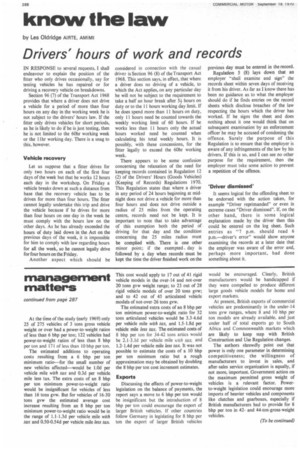Drivers' hours of work and records
Page 290

If you've noticed an error in this article please click here to report it so we can fix it.
by Les Oldricige AIRTE, AMIMI
IN RESPONSE to several requests, I shall endeavour to explain the position of the fitter who only drives occasionally, say for testing vehicles he has repaired or for driving a recovery vehicle on breakdowns.
Section 96 (7) of the Transport Act 1968 provides that where a driver does not drive a vehicle for a period of more than four hours on any day in the working week he is not subject to the drivers' hours law. If the fitter only drives vehicles for short periods, as he is likely to do if he is just testing, then he is not limited to the 60hr working week or the 1 [hr working day. There is a snag to this, however.
Vehicle recovery
Let us suppose that a fitter drives for only two hours on each of the first four days of the week but that he works 12 hours each day in the workshop. On Friday a vehicle breaks down at such a distance from base that the recovery vehicle has to be driven for more than four hours. The fitter cannot legally undertake this trip and drive the vehicle because if he drives for more than four hours on one day in the week he must comply with the hours law on the other days. As he has already exceeded the hours of duty laid down in the Act on the previous days of the week, it is impossible for him to comply with law regarding hours for all the week, so he cannot legally drive for four hours on the Friday.
Another aspect which should be considered in connection with the casual driver is Section 96 (8) of the Transport Act 1968. This section says, in effect, that where a driver does no driving of a vehicle, to which the Act applies, on any particular day he will not be subject to the requirement to take a half an hour break after 5-f hours on duty or to the 11 hours working day limit. If he does spend more than 11 hours on duty, only II hours need be counted towards the weekly working limit of 60 hours. If he works less than 11 hours only the actual hours worked need be counted when calculating his total weekly hours. It is possibly, with these concessions, for the fitter legally to exceed the 60hr working week.
There appears to be some confusion concerning the relaxation of the need for keeping records contained in Regulation 12 (2) of the Drivers' Hours (Goods Vehicles) (Keeping of Records) Regulations 1970. This Regulation states that where a driver in any period of 24 hours beginning at midnight does not drive a vehicle for more than four hours and does not drive outside a radius of 25 miles from the operating centre, records need not be kept. It is important to note that to take advantage of this exemption both the period of driving for that day and the condition concerning the 25 miles radius must be complied with. There is one other minor point; if the exempted day is followed by a day when records must be kept the time the driver finished work on the previous day must be entered in the record. Regulation 5 (8) lays down that an employer "shall examine and sign" the records sheet within seven days of receiving it from his driver. As far as I know there has been no guidance as to what the employer should do if he finds entries on the record sheets which disclose breaches of the law respecting the hours which the driver has worked. If he signs the sheet and does nothing about it one would think that on subsequent examination by an enforcement officer he may be accused of condoning the offence. Surely the purpose of this Regulation is to ensure that the employer is aware of any infringements of the law by his drivers. If this is so, and I can see no other purpose for the requirement, then the employer must take some action to prevent a repetition of the offence.
'Driver dismissed' It seems logical for the offending sheet to be endorsed with the action taken, for example "Driver reprimandedor even in extreme cases "Driver dismissed". If, on the other hand, there is some logical explanation made by the driver then this could be entered on the log sheet. Such entries as "7 p.m. should read 6 p.m.—driver's error" would show anyone examining the records at a later date that the employer was aware of the error and, perhaps more important, had done something about it.






























































































































































































































































































































































































